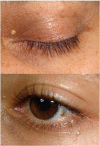Periocular dermatoses
- PMID: 29234715
- PMCID: PMC5715233
- DOI: 10.1016/j.ijwd.2017.08.001
Periocular dermatoses
Abstract
The periocular area may be affected by infectious or noninfectious diseases such as inflammatory dermatoses, systemic disease, drug reactions, benign and malignant lesions, traumatic lesions, and esthetic complications. We present a review of the most common periocular dermatoses.
Figures






























References
-
- Abalo-Lojo J.M., Cameselle-Teijeiro J., González F. Pilomatrixoma: Late onset in two periocular cases. Ophthal Plast Reconstr Surg. 2008;24:60–62. - PubMed
Publication types
LinkOut - more resources
Full Text Sources
Other Literature Sources

